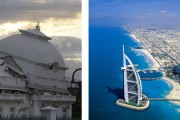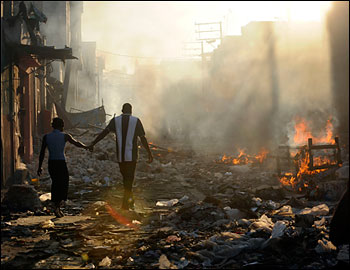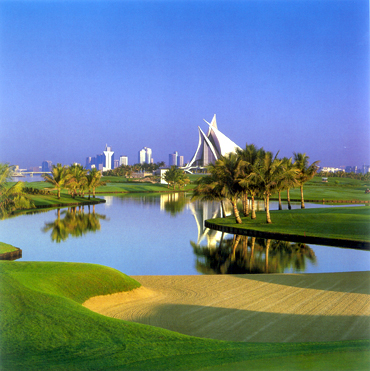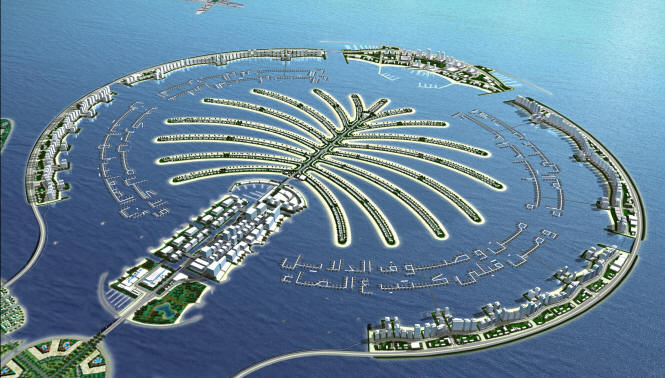
From Dubai to Haiti: Richard Best, Sustainable Architect
by Rebecca Firestone with Mark English AIA | Interviews
“A master plan has to take into account the natural and economic resources available in the region.…You have to think about commerce. In order for such a plan to be effective, it has to include more than pretty buildings. It has to be realistic. You can’t plan on exporting pineapples from Haiti for example – not enough arable land for it.
For sustainable development, unfortunately the best opportunities often present themselves in the form of natural disasters, such as Haiti’s recent earthquake. This is an opportunity to turn human tragedy into a triumph by creating better, more livable cities.”
When Michael Bernard suggested that we interview architect Richard Best, it was because Richard had, after losing three projects in one day, auditioned for a reality TV show a la Donald Trump’s “The Apprentice”, but set in Dubai. Almost every architect today can relate to the very real possibility of losing their entire business in the recession; it’s happened to so many already.
But then, as it turned out, Best had even better things up his sleeve than that, although Dubai was where our conversation began. Dubai has been in the news most spectacularly – first as a success story, and then as another casualty of the global financial crisis. I wanted to find out what it was really like to work in the “Disneyland of the desert”.
Dubai is part of the United Arab Emirates, or UAE, a federation 7 emirates, each ruled by one family. Dubai is one of these Emirates, and Abu Dhabi is another. (The other 5 don’t seem to appear individually in the news as much). Dubai and Abu Dhabi are both ruled by dynastic hereditary monarchs. Their citizens are called Emiratis, and are qualified by bloodline relation to the ruling royal families.
— Interview —
Let’s catch up from the last big media update, which was the reality TV show. That show finished up before the big economic crash here in 2008, which was then followed by Dubai’s sudden debt crisis which appeared in the news around the end of last November. So what’s going on now with your partnership with Hydra in Dubai? I see Dr. Fahim is no longer the CEO of Hydra. Is Hydra even still around?
Happily, I can report that I’ve received my $1M winnings from the show. Hydra, along with other companies in the United Arab Emirates, are finishing the projects they started, but new development is very limited at the moment.
Unlike Abu Dhabi, which is more oil-rich, Dubai had based its entire economy on real estate [with heavy borrowing]. And then, their bubble burst. Dubai recently got huge bailout from the other Emirates. Collectively, the UAE sits on 10% of the world’s oil so they’re doing OK.
It’s true that Dr. Fahim is no longer CEO of Hydra. He’s still got international interests, including buying up two British soccer teams, Manchester United and Portsmouth.
I bet the British loved that.
They sure didn’t! But Hydra is still afloat. They’re a subsidiary of The Royal Group, which is owned by the Abu Dhabi Royal Family.
Are you still a partner at Hydra?
The plan for the winnings was a bit changeable. It was always $1M, but it was up in the air whether that would be in cash, or a business interest, or something else. Then, when Dr. Fahim left Hydra, it wasn’t clear whether I would be involved with Hydra or with him directly. I actually wrote two very detailed business plans during my time on the show, one for Hydra and one for Dr. Fahim.
But then the economies all went south and Hydra was no longer looking for a new design partnership. However, I still have a great relationship with Dr. Fahim – both professionally and personally.
I know it’s off topic, but I can’t help wondering what it’s really like over there. In that TV show, the upfront scenes had NO women at all, except for one beautiful woman in a white head-scarf. There were women on the reality show at least. Dubai is portrayed in the news media as a sort of Disneyland in the desert – not very Arab, and totally out of place.
You know, I never thought to look for that, but it’s true. The social scenes are contained in hotels and clubs. Emirati women in general wear headscarves unless they’re a youthful rebel. The older women walk a few steps behind their husbands. In the Emirates, life takes place from one building to another, because it’s so oppressively hot outdoors 9 months out of the year.
Like Houston. Everyone in Houston is indoors in air conditioning all the time.
Yes, it’s like Houston only more intense. The Emirates are as humid as Florida but without any cool breezes. Sometimes there’s a HOT breeze. Comfortable spots can be found around the pools and at the hotels.
Well, how do regular people fit in? Aren’t there any ordinary schlubs over there?
Not really. If you’re not an Emirati, you need a work permit to be in the country for more than a few months. Every 60 days, we had to cross the border to Oman and return in order to renew our visas. The lower-level service jobs are all imported labor. They live in labor housing, which was pretty nasty until 60 Minutes did an expose on worker conditions. Then things improved for them somewhat.
The remaining members of the public live in expensive apartments, often sharing them with roommates to be able to afford them. And, you have to pay a full year’s worth of rent upfront.
What’s the civic life like over there? Is there one?
The population consists of temporary labor and Emirati citizens. Emiratis are only about 10% of the total population. There is no native middle class as we would understand it. There are some professionals like me – architects like me, engineers, legal professionals, entertainers – all foreigners. But people like me are not citizens. The entire middle class is imported.
There is little interaction between the white-collar people and the laborers.
Ownership is limited except in designated Free Zones, where foreigners can own real estate property outright. For business partnerships, however, an Emirati partner usually must own 51% or more of any enterprise, so a 49/51 split is one predominant arrangement.
Western cultural life takes place inside hotels – Western movies, theater, and art. There is Emirati culture, but that takes place exclusively inside people’s homes. I haven’t had the opportunity to visit that many private homes.
Are all the Emirates the same regarding their cities?
No, they’re not, because each one is ruled by a separate family with its own idiosyncrasies. Abu Dhabi, for example, has a master plan called the 2030 Plan. Dubai, however, built first and planned later. As a result, the streets and transport are a little bit chaotic. It was a frenzy of build, build, build – funded by investments from the ruling royal family.
What about sustainability?
Dubai is glitzy. They’ve got a mall with a ski slope inside it, in the middle of a desert! How sustainable is that?
Abu Dhabi, on the other hand, is sustainable. It’s called out very clearly in their 2030 master plan. They intend for Masdar City [one of their urban districts] to be the world’s first Zero Carbon City. I would love to work there and be part of that.
So what would you do with Dubai if you were the ruling prince? What if you could wave a magic wand and implement your desires?
I would STOP construction except for things that are almost finished already, and get a master plan in place that is sustainably oriented. Like the plan for Abu Dhabi. The Emirates are a perfect laboratory for testing sustainability. Plenty of sun, few violent storms, lots of water, tidal action, and oil. But there isn’t much patience for that sort of thing in Dubai. They don’t want to wait until 2030.
I did my first green building in 1979, and I couldn’t get anyone to listen to what was then called “solar design”. Now of course it’s a huge deal, because it’s hitting people in their pocketbooks.
How can a country that’s such a huge oil producer even talk about sustainability? Won’t they just be eliminating their own revenue?
They’re working on [being producers and exporters of] new sources of energy. I like to say that The UAE will liberate itself from oil before we do!
Why’s Abu Dhabi so much more forward-looking than Dubai? Aren’t they all related monarchies? Maybe it’s the same as the old European monarchies, though – some were good, some not so good.
Abu Dhabi is like Washington, D.C. It’s sedate, deliberate, established. Dubai is more like Las Vegas – louder, and more in the public eye.
I remember being in Kuala Lumpur, Malaysia around 1995, before the Asian financial crash. They were building 24 hours a day over there!
There was 24-hour construction in the UAE, too.
But in KL, I don’t remember seeing much of a civic life. In Manhattan, for example, there’s so much to do. Museums, lectures, libraries, concerts, and more. In KL there could maybe have been a symphony.
That’s true. There’s not much civic life in Dubai or the UAE as a whole, and what there is, it’s all in hotels. Western culture can be found in hotels and malls, whereas Emirate culture is kept at home. Emirati culture is very different than ours, very private.
Didn’t someone propose a $500M dance museum?
Yes, that was one of my competitors during the audition for the show.
[a side discussion on the role and status of performing arts in the Arab countries in general, since I think a dance museum would be a great idea – maybe $50M instead of $500M though]
I did not have an opportunity to see any performing arts outside of the hotels, and what I saw was all Western. Their own performing arts like bellydance was always a private thing for them. Symphonies are Western. Actually, they seem to import all their art – Gehry designs, or museums filled with art from around the world. [nothing that was purely regional]
But the UAE is so young. In 1957 it was only Bedouin tribes there. IT wasn’t till 1970 that the 7 families united into the 7 Emirates. Dubai is even newer, maybe starting in the 80s, even the 90s. Prior to that, the tribes had been there for eons of course – pearl divers and falconry. [traditional occupations]
What about the royal families? What are they like? I mean, we have people like Warren Buffett who have very definite personalities, opinions, and passions.
The royal family members are often British-educated or American-educated. They have a very strong sense of cultural pride. They’re not Saudi, they’re not Persian – they’re Emirati. One positive aspect of the royal families is they pay attention to their own people. There’s socialized medicine [but you must be of the bloodline to qualify for the privileges of citizenship].
They’re hip on education, and most Emiratis are college educated. Women, too. But, only 10% of the population is actually Emirati. The rest are foreign laborers or professionals like me.
So essentially the society is based on cheap foreign labor. Is that sustainable, ecologically and sociologically?
It’s sustainable as long as they’ve got a soaring economy.
I’ve been reading Lewis Mumford’s historical essays on cities from the medieval period on forward. Some of those earlier city planners were extremely ambitious, and they wanted nothing more than to remake their entire society by reshaping the cities. What do you think of this notion of architect as social engineer?
If the money is willing to go there, so are we. We provide the thinking, but someone else has to provide the money.
Would you create a master plan for Dubai that was exactly like Abu Dhabi’s?
No, because a master plan has to take into account the natural and economic resources available in the region. Abu Dhabi’s master plan includes cultural heritage, commerce, and alternative power. You have to think about commerce. In order for a master plan to be effective, it has to include more than pretty buildings.
I’m doing a plan for Haiti right now [discussed further on] that includes among other things renewable energy. But these plans reference other things that have to happen, and these things include a realistic assessment of local commerce. You can’t plan on exporting pineapples from Haiti for example – not enough arable land for it. You have to be realistic.
[We discussed other countries like India and Ireland]
Now what Haiti could do would be to reposition itself a s a virtual-based business the way India did. India learned to export its skills in CAD, accounting, software engineering, and offshore support centers. In order for that to work in Haiti, though, you have to include an education plan based towards that type of commerce. You need more than school buildings, you need a curriculum too.
I’ve noticed some differences in performance between India and the US in terms of technical skills or maybe it’s attitude. The Indian software development teams were more methodical, but less likely to think outside of the box, and less likely to take responsibility for anything that wasn’t right in front of them on their own desks.
Americans are really geared towards thinking outside of the box. It’s in our blood, almost. Not every place is like that.
Maybe there’s something to that notion of Yankee ingenuity and the pioneering spirit. I’ve always taken American individualism totally for granted. But what are we missing?
Well, environmental degradation is one of the results of unbridled individualism. We are the biggest users of raw materials and energy per capita in the world.
So in a sense Americans are that 10% and the rest of the world is our “serf”.
You could look at it that way, yes.
Back to Dubai’s hypothetical master plan. What would you do different than Abu Dhabi’s master plan?
I actually know Abu Dhabi better, but let me think… Dubai has ports and shipping capability. In the UAE, they wanted to make themselves a global stopover port, and invested heavily in airports and tourism. Dubai has a pretty cool mass-transit system, with interesting stations and kiosks. I’d expand that, increase density and discourage suburban blight. Dubai could promote tourism, perhaps even eco-tourism.
I can’t imagine eco-tourism in a place with just sand. It looks like Mars. Not like the American Southwest, which has such majestic rock forms. I don’t know if the deserts of Dubai would have that much appeal. But, they have all that water. Couldn’t they use it to grow things?
All that SALT water, you mean? There is a $700M desalinization plant in Dubai. They don’t have much in the way of raw materials – no timber, no forests, very limited fertile soil, no rivers, no minerals to mine. Just lots of sand. So they can’t make steel, but they can make concrete. Even with the concrete, they have to import the adhesive.
Originally, I thought desalinization was a sin. But it can actually help preserve freshwater aquifers by taking some pressure off them. Sacramento is one example here [tension over water use is pitting farmers against environmentalists]. But nobody is doing it properly, yet. Water is a finite global resource. All the water that was originally on the planet is still here, in the ground, on the ground, and in the air. IT’s a closed system.
What design projects are you working on now?
There are very few projects, but the ones we have are all on track for LEED Gold certification. They include a pet grooming and day care center, and a nail salon.
But what else? You mentioned Haiti. What is your involvement there?
I received an Intergovernmental Renewable Energy Organization 2009 Best Practices Award from the United Nations for my career-long commitment to sustainable design. They asked me to form a new commission under the auspices of the IREO which has a mission to promote renewable energy around the world. The IREO needed specific expertise in buildings and city planning and they approached me to form the Sustainable Development Commission (the IREO-SDC).
For sustainable development in underdeveloped nations, unfortunately the best opportunities often present themselves in the form of natural disasters, such as Haiti’s recent earthquake. This is an opportunity to turn human tragedy into a triumph by creating better, more livable cities. In order to create better infrastructures, you do have to remove the old ones. A natural disaster can force these changes and provide the raw material for rebuilding.

Natural disasters such as Haiti's earthquake, terrible as they are, can still open the way to rebuilding in a better way.
The Sustainable Development Commission doesn’t focus on relief. There are other organizations for that. We focus on reconstruction plans, which include new utilities, new sources of energy, and greater efficiency.
There’s such a difference between Haiti and Chile in terms of the aftermath of their recent quakes.
The four or five buildings in Haiti that are still standing were all American-built, or so I hear. But, the need for reconstruction there is also an opportunity for great improvement. Haiti could even have the world’s first NEGATIVE carbon city – a city that produces more energy than it consumes.
What do you think of Michelle Kaufmann’s ideas for prefab housing as an alternative to temporary housing? Her idea is that temporary rescue housing, like those toxic FEMA trailers that were in use after Hurricane Katrina, are actually a detriment, because then they become permanent and they were never meant to be.
We’re about to meet with her group, actually – Architecture for Humanity. For Haiti, though, our plan is a little different, and involves a couple of stages. First, we want to get the survivors into palatable living conditions as quickly as possible. This means moving them away from the rubble into immediate shelter, so that we can remove debris safely and lay down new infrastructures.
Since the reconstruction may take several years, we might need to move people again so that they have someplace to live in this interim period which could be 10 years. So, one idea is housing that can move, can be transportable, but will still provide shelter from hurricanes.
During that 10 year interim period, you could start educating people so that they will have the skills at the end of it to participate in a new economy. It takes a long time to socialize people so that they have not only job skills but the right mindset to step into new roles.
Yes, you’re creating a new generation.
Another thing we’d like to do is regarding land and agriculture, re-forming and terracing the soil to stabilize it, and prevent future mudslides. And reforestation. There’s an area there that is suitable for a tree nursery, where we can grow seedlings and then replant them.
How are the Haitians doing right now? They are in a national trauma. Will they even be able to cope with all this reconstruction?
They’re pretty angry. Angry at their own government, among other things. That’s one reason we have a financial aspect to the redevelopment, for anti-corruption. In our plan, every disbursement will have three signatories – one representative from the Haitian government, one from IREO, and one from the granting organization.
Do you have any famous last words to close with?
Yes! Encourage people to support the work of the IREO Sustainable Development Commission, which is just getting off the ground. We just had our first meeting, and already we have $5M from a humanitarian source for rebuilding in Haiti. That is what we should be focusing on.
One Response to “From Dubai to Haiti: Richard Best, Sustainable Architect”
Leave a Reply
You must be logged in to post a comment.









New Orleans Make It Right: A Vanity Exercise? | The Architects' Take
21. Dec, 2013
[…] few months ago we interviewed Richard Best, an architect who had worked in Dubai and was then seeking to join with Architecture […]